In the ever-evolving field of pharmacology, understanding the intricate mechanisms by which drugs interact with their targets is paramount. Remarkably, about one-third of all FDA-approved medications exploit a specific group of receptors known as G protein-coupled receptors (GPCRs). These receptors play a critical role in maintaining human health, aiding in the treatment of a variety of conditions, from heart disease to allergies. Conventional wisdom has often reduced these complex interactions to straightforward one-to-one relationships between a drug and its target receptor. However, recent research reveals a far more nuanced picture, demonstrating that many drugs interact with a series of protein complexes that include GPCRs and their associated proteins, known as receptor activity-modifying proteins (RAMPs).
This new framework for understanding drug interactions comes from a groundbreaking study published in *Science Advances*, which provides novel insights into the interplay between 215 GPCRs and three specific RAMPs. The implications of this research reach beyond mere academic curiosity; it opens new avenues for drug discovery and development. Ilana Kotliar, the study’s first author, emphasizes the significance of these findings, highlighting both a technical marvel in mapping these receptor interactions and a biological revelation that such complexities are more widespread than previously acknowledged.
The intricate relationship between GPCRs and RAMPs can be likened to an elaborate dance where timing, position, and interactions dictate outcomes. RAMPs do not merely associate with GPCRs later in their life cycle; they are essential for transporting these receptors to the surface of the cell, effectively altering their functionality. This extensive role of RAMPs implies that the effectiveness of a drug targeting a specific GPCR may depend significantly on the presence or absence of specific RAMPs within different cellular environments.
With the realization that finding a GPCR without acknowledging RAMP impact is akin to taking a restaurant menu at face value without considering the establishment’s operational hours, researchers like Thomas P. Sakmar are motivated to fully explore these receptor-protein dynamics. Sakmar’s team aimed to create a comprehensive mapping technique to investigate the influence of RAMPs on GPCRs. Their approach not only enhances drug development processes but may also shed light on why certain GPCR-targeted medications fail to produce expected results.
Another critical motivation behind this research is to decode the mystery surrounding orphan GPCRs—receptors whose natural ligands remain unknown. Knowing which RAMPs are paired with these GPCRs could offer vital clues to their activation and downstream effects on human physiology, potentially leading to significant therapeutic breakthroughs.
Despite the potential benefits, mapping every possible GPCR-RAMP interaction poses significant challenges. With approximately 800 GPCRs and merely three known RAMPs, the combinations become overwhelmingly complex. In response to this hurdle, a collaborative effort began in 2017 led by graduate student Emily Lorenzen from Sakmar’s lab. This partnership, embraced by scientists from Sweden’s Human Protein Atlas Project, laid the groundwork for developing a high-throughput assay capable of screening multiple interactions simultaneously.
Utilizing magnetic beads coated with antibodies and color-coded dyes, this innovative laboratory technique allowed for parallel assessment of GPCR-RAMP interactions. By monitoring the interactions of 215 GPCRs and RAMPs in one experimental run, researchers gained access to an unparalleled breadth of data that could propel the current paradigms of drug discovery.
The outcomes of this research are transformative. With publicly accessible libraries detailing anti-GPCR antibodies, engineered GPCR genes, and interactions with RAMPs, researchers are better equipped to explore the pharmacological landscape and develop targeted therapies. The affordability and efficiency of the innovative methodology pioneered in this study offer a crucial step forward, streamlining processes that could unravel the complexities surrounding drug efficacy.
As a result, not only has the number of identifiable GPCR-RAMP interactions increased exponentially, but the study lays the groundwork for future investigations that aim to discern how these interactions contribute to drug action. Sakmar envisions this project as a technological advance designed to facilitate research and the understanding of pathophysiological phenomena, such as harmful autoantibodies and multi-receptor complexes.
The exploration of GPCR-RAMP dynamics may very well shape the future of drug discovery and development, enabling scientists to harness the full therapeutic potential of GPCRs. As research continues to illuminate these complex systems, the opportunities for innovative treatments tailored to enhance human health multiply significantly, heralding a new era in medicinal science.


Leave a Reply